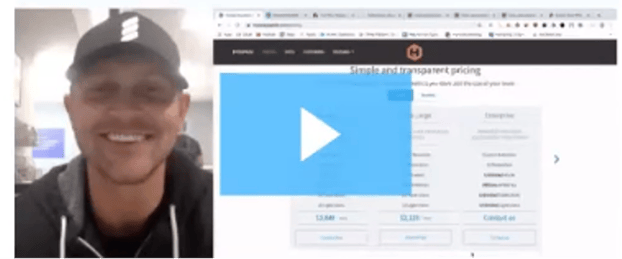Table of Contents

The phone rings. It’s the sales rep from that new gym you’ve been checking out. Do you pick up? Or do you dismiss the call after a few rings?
If you chose not to answer the phone, you’d be in the majority. And that holds true even if you had every intention of signing up for the membership.
It all comes down to the simple fact that most people do not like talking to sales representatives.
If you’re in sales: it’s not you, I promise. I’m sure you’re lovely. And a great listener. People love talking to you on the phone – just not necessarily when you’re selling something.
Now why is that?
There are a few psychological factors at play here.
The first is scepticism.
A Healthy dose of Scepticism
Our predecessors had to learn the hard way not to be quite so trusting. That fallen tree over there? Look again mate, that’s a crocodile and it took Bruce last Friday. Tempted by those delicious-looking berries? Go on, you’ll be dead by sundown.
In the modern day, we apply much of that same scepticism to our financial and emotional survival.
Generally speaking, we don’t blindly trust the packaging, we check the list of ingredients.This item is on sale? Great, but is it actually good value, and do I really need it?This platform is free to use, but how will my private data be handled?
These are very important questions to be asking, and show that we’ve gotten wise to some of the more questionable marketing tactics and business practices we’ve been subjected to over the decades.
Unfortunately, this also means that our guard is up even when it comes to being sold a product or service that can actually help us.
It’s an innately natural response to feel that the more someone tries to convince us of something, the more we want to resist.
This brings us to a need for control.
Buyers need to be in control
When the phone rings, or an email pops into our inbox, we are put in a reactive position. We don’t control the timing, and we don’t control the narrative.
And not being the driving force in a situation rubs a lot of people the wrong way right out the gate – especially founders who’ve essentially built a business on proactivity.
I’m not saying ‘don’t call founders’. I’m saying, consider how you can hand over some of that control, whether real or illusionary. It could even be small things, like letting them decide the timing for a call.
Finally, there’s an impliedpromise in taking a sales call.
Don’t guilt people into promising you something
Knowing that the other party has a specific goal that we have the sole power to either fulfil or deny, adds stakes to a conversation.
We might even feel indebted to a sales rep for taking up their time.
This puts pressure on buyers and makes them feel guilty for not fulfilling the wishes of the sales rep.
Essentially, these three factors can make a prospect feel like they’re always on the back foot.
As a sales person, knowing that it’s most likely not your fault that prospects aren’t answering your calls is but small consolation when it’s affecting your sales numbers.
However, understanding the psychology behind this phenomenon can help you improve not only your approach, but your entire campaign strategy.
So how do we combat these psychological tripwires?
Take away the pressure
The solution is anathema to most marketing strategies: take away the goal of selling anything.
Yes, spending campaign money that might never see returns is risky and counter-intuitive. In any case, the results will be unpredictable, and perhaps only come to fruition in the long term.
Something magical happens, however, when you take away the pressure to buy.
The connections you make through alternative marketing run on different tracks entirely to the usual sales funnel: instead of converting prospects, you develop business partnerships, form long-term trust relationships with peers, and build your brand identity.
Here are a few ideas on alternative marketing strategies:
Tip 1: Build community
- Events
- Blogs, workshops, mentorship
Tip 2: create a word-of-mouth buzz
- collaborations
- features
Tip 3: make high-touch contact
Tip 1: Build community
Events
Hosting events is a great opportunity to meet and develop a community of business partners, peers, and potential customers.
Some ideas of occasions to create events for include company anniversaries, achieving a major business milestone such as funding or acquisition, change in leadership, new hires, and launching a new campaign.
You could treat these events as customer discovery too, and ask participants for light feedback on your services.
The point is that community-driven events shouldn’t revolve directly around sales at all.
Instead, these are an opportunity for your community to see the values that you as the founder, as well as your business, are built upon.
What could those events look like?
Depending on what’s feasible for your business and what makes sense for your product, these events can be in person or online, and range from invite-only curated dinners to open attendance pop-up stalls.
Note that if you’re hosting an online event, it’s especially important to create an incentive for people to actually show up and participate. This could be through raffle prizes, information give outs, or simply sending out quality RSVP cards.
This will also help allocate your marketing funds more effectively – if someone can’t commit to an RSVP, they certainly won’t commit to your business long-term.
Blogs and information sharing
Another method of community-building is through information sharing.
When you’re in the starting phases of customer discovery, blogs, video content, and podcasts with good SEO are powerful tools for attracting a wide range of people, some of whom could eventually become clients based on the quality of your content.
You might consider giving this community a voice by hosting a comment section, or another means to respond to your content to attract more engagement.
It’s usually a good idea to separate your marketing outbound domain from your main business domain, and this goes double for any community-uploaded content. Remember, you can always import some of those contributions (with permission from the authors, of course) to your main business profile as testimonials.
Take your community to the next step by offering workshops and mentorship.
Workshops and mentorship
Ideally, workshops should be monetised, not only to offset some of the costs of your alternative marketing campaign but also to encourage participants to truly commit. When it comes to information, people really do value paid content over the free variety.
Even though the educational route in alternative marketing takes a less direct approach to sales, this doesn’t mean you’re not looking for long-term returns. The goal is absolutely for a proportion of workshop participants to eventually become customers, business partners, or even your new team-members.
To reap the full benefits of this approach, you need to commit to keeping people engaged in your content longer-term. If this level of commitment to the indirect sales approach isn’t practicable for your business in the long term, read on to the next tip on shorter term content ideas.
Tip 2: create a word-of-mouth buzz
Collaborations
Going viral and getting people to recommend your services without recompense is not a process you can fully control. But there are a few things you can do to further your organic reach.
Collaborations are a prime example. Contacting related businesses to run a joint campaign will not only allow you to reach each other’s audiences, but could also give you some fresh ideas for your own startup.
In order to find potential partners, think of services that are compatible with yours, but not in direct competition. As a SaaS business, your immediate ‘product neighbours’ likely include online payment systems, project management tools, and any other tools that your customers also use.
Of course, you can also go further afield and collaborate with any business with whom a joint campaign makes sense.
Let’s say your SaaS provides a service that helps reduce paper waste and energy consumption. Environmental groups would make great partners for a ‘Go Green’ campaign.
Get featured in influencer content
Another way to achieve word-of-mouth attention is to be featured by influencers and content creators active in your field. These promotions could be paid, equivalently reward-based, or in some cases purely organic.
The closer the content of a given medium aligns with your services, the more audience members will be interested in converting to your product.
The benefit of this is that instead of having to build up a following of your own, you have access to the existing audiences of content creators across a multitude of channels and interests.
If eventually you did want to invest in creating a social media following of your own, you have a few ‘media personas’ to choose between, all the way from the ‘informative blog’ like Baremetrics, to the ‘merciless roast channel’ like the Wendy’s infamous twitter account.
Tip 3: make (ostensibly) high-touch contact
In his book How to Get a Meeting with Anyone, famous Wall Street Journal cartoonist Stu Heinecke describes his tactics for scheduling meetings even with the most elusive of people.
How? With an arsenal of unique, high-touch campaign strategies that include, you guessed it, drawing cartoons.
Is this approach effective? Yes.
Is this method fool-proof and efficient? Absolutely not. So use it wisely.
And by ‘this method’, I don’t exclusively mean ‘draw cartoons’. What your upper echelons of personalised contact look like is entirely up to you!
In essence, this high-touch approach is a ‘special occasions’ kind of contact to be reserved for the most promising of prospects, and potential business partners of VIP status.
Now what if I told you that there’s a cheat code?
Use technology to customize your communication
With new technology ever evolving, software can now emulate a high-touch approach that requires only a small amount of customisation.

Lemlist offers one such service. Its artificial intelligence creates custom images and video content that appears to be unique to the prospect.
How does it work?
Essentially, the customisation process is the same as for any cold email template.
It’s a broadly one-size-fits-all email that contains a personalised hook adapted to each prospect.
In the case of a video message, the custom-made hook is a recorded screen-grab of the prospect’s home page, while the other side of the spliced video featuring the sales person remains exactly the same.

Here’s what that looks like. On the left is a template recording of the sales rep. On the right is a screengrab of the prospect’s own pricing page.
Of course, the video and audio won’t sync properly for any customised lines, such as the prospect’s name. This is masked quite easily with a small glitch effect that looks like a buffering issue.
Ingenious, right?
In a few years, this approach might become standard. As it stands, this technology is pretty novel, and rarely fails to create quite the first impression.
The take-away: don’t hesitate to use technology in unorthodox ways!
Conclusion
Ultimately, alternative marketing is underpinned by three core concepts:
Approach people as people, not as prospects
In a world where we’re incessantly being sold to, that feels incredibly liberating.
New technology makes new methods
The second is, don’t be afraid to experiment with new methods, new technologies, and lean into what makes your SaaS unique.
Be meaningful
And finally: however you do it, make the first contact meaningful.
All the data your startup needs
Get deep insights into your company’s MRR, churn and other vital metrics for your SaaS business.




